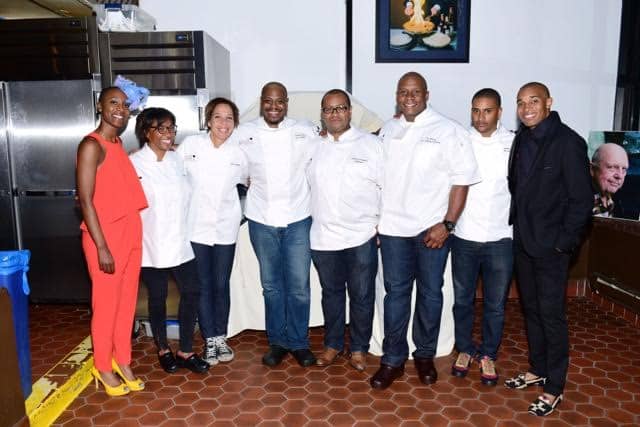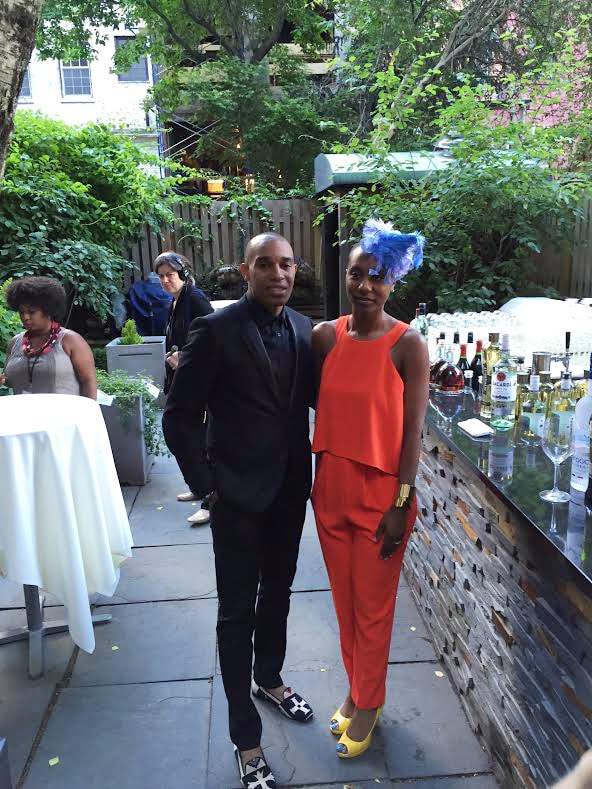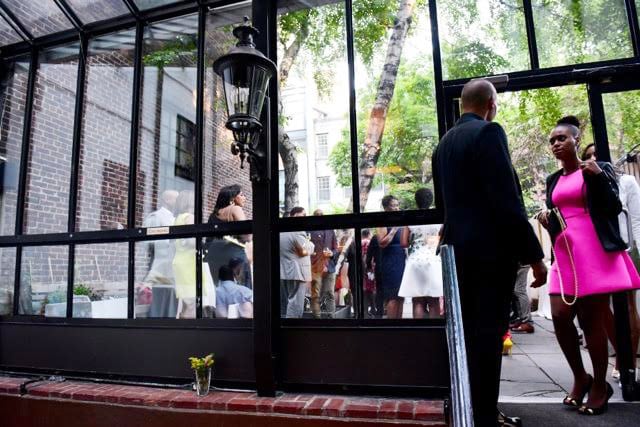Walk down West 12th Street in Manhattan and you’ll pass by a number of large, valuable, but rather nondescript buildings. Pause about a quarter of the way down the block, mere steps from a Duane Reade pharmacy and the 14th Street subway stop, and you’ll find a small plaque identifying one of the many stone buildings as the epicenter of the American food world: the James Beard House.
It is the location of a hugely influential and powerful institution based in what is quite literally the home of its namesake, James Beard. Beard was a towering figure in the culinary world (also literal, he was a big guy in terms of stature, personality, and girth), and after his death his New York City home became the center of operations for the Foundation, which would continue his work by encouraging education, artistry, and excellence amongst cooks and chefs across the world.
It’s said that to cook in the kitchen of the James Beard House is an honor unto itself, and it’s not hard to see why. The house, while enormous by New York City standards of square footage, has the cramped, homey feel that one encounters when visiting a treasured grandparent or eccentric family friend. On the ground floor is a small room which serves as a foyer and meeting place for guests, and through which lies the kitchen: a low-ceilinged box of a room where all available walls are covered in photographs and hanging cooking utensils, and where every inch of counter space is used for prepping ingredients, mixing sauces, and plating meals.
Up a tight staircase, the second floor houses the dining room, the third floor offices, and the fourth (and top) floor meeting rooms, complete with food-and-drink stained animal-print carpet and rows of bookshelves filled with award-winning cookbooks. In short, it’s a fascinating place, almost indescribably eclectic and welcoming. If an important part of the dining experience is the environment in which it takes place, the James Beard House is somewhere that people could learn from.
On the evening of June 6th, I am in the James Beard House to attend an event billed as The Iconoclast Dinner Experience. This dinner, chaired by Dr. Lezli and Chris Harvell and held in conjunction with the Dental Kidz Foundation, named after their private dental practice which almost exclusively sees underprivileged children from Newark, NJ and the surrounding area, benefits The Dr. Lezli Levene Harvell Scholarship for International Students at Spelman College.
Unknown content block type: FlexiblePageTemplateFlexibleContentPhotoFullWidthLayout
{
"__typename": "FlexiblePageTemplateFlexibleContentPhotoFullWidthLayout"
}The specifics of the Harvell Scholarship fund are what make this meal distinctive. The Harvell Scholarship benefits students from Jamaica and sub-Saharan African countries who wish to attend Spelman College, a historically black women’s college located in Atlanta, Georgia.
For some, the geographical description may need a bit of code-breaking. It was only recently, when visiting the country of Tunisia in Northern Africa, that I heard two different terms being used: those actually living in North Africa referred to themselves as living in “Arab Africa,” while those living beneath North Africa, an area split from the rest of the continent by the Sahara Desert, were referred to as being in “Black Africa.”
The Iconoclast Dinner seeks not only to provide college funding for women who otherwise could not afford an American college experience, but also highlights the fact that many of our best chefs are men and women of a diverse background, both racially and geographically. All of the eleven celebrated chefs, sommeliers, and spirits professionals involved in the preparation of food and drinks for the evening were people of color, with several hailing from outside the United States.
Pre-dinner cocktails were developed and prepared by Colin Asare-Appiah, co-founder of the London Academy of Bartending, co-host of the British Discovery Channel show Cocktail Kings, and National Training Manager for Bacardi. Asare-Appiah’s recipes were well-balanced and inventive, the most distinctive of which was the Otis, which blended D’usse cognac, Martini Rosso vermouth, and an umami-laden reduction of Guinness and Marmite.
Wine pairings were selected by award-winning sommelier Luvo Ntezo of South Africa. After-dinner cocktails were designed and prepared by Junior Merino, “The Liquid Chef,” and incorporated ingredients such as grilled pineapple and liquid nitrogen.

Of the chefs involved with the dinner, national and international recognition was common. Tre Wilcox, twice-nominated for the James Beard Foundation Rising Star Award and Top Chef alum, prepared a lobster ceviche with jalapeno gazpacho, pureed banana, avocado, and crispy plantains. Following Wilcox was Nina Compton, a Top Chef “Fan Favorite” and runner-up, who just recently opened her first restaurant in New Orleans, Compère Lapin; she prepared a poached octopus with heirloom tomato and smoked potato puree.
One of the best dishes of the evening was prepared by Preston Clark, another James Beard Foundation Rising Star Award nominee. Clark presented diners with steamed black bass with shaved radish, ginger, and a white sesame vinaigrette. Following Clark was Nyesha Arrington, who simultaneously competed on Top Chef and on the Food Network show Chef Hunter, where she was crowned champion. Arrington prepared a duo of duck with sweet potato galette, glazed peaches, and roasted jus.
The last of the entrées was presented by 2015 James Beard Foundation Rising Star Award semifinalist Joe “JJ” Johnson, who prepared braised goat with West African peanut sauce, corn mash, and cherry cilantro salad. Capping the meal was a lemon verrine with lemon sherbet and caramelized feuillete, prepared by Graham Hornigold, the Craft Guild of Chefs UK Pastry Chef of the Year.
The meal was remarkable not simply because of the quality of the ingredients or the setting itself. To look upon the world of food that is often projected into our homes is to see a vision of predominantly white faces. This dinner, to benefit a scholarship specifically designed to elevate Jamaican and African women, recognized that the people who prepare our food, and who prepare some of our best food, do not belong to a monochromatic color palette. Anyone who has worked in a restaurant can tell you that the vast majority of the food we consume, be it a sandwich from a corner deli or a traditional meal at an upscale French restaurant, is produced by chefs from a variety of backgrounds, who hail from around the world. Unfortunately, it is this true and accurate view of who exactly is preparing our food that is often overlooked by our wider society.
The chefs invited to cook at the James Beard House demonstrated that in the culinary arts, and particularly in the world of fine dining, race should not be a barrier to success or professional acknowledgment. The slate of awards, nominations,


and career-launching television opportunities of these chefs, these icons, should serve as an inspiration to the new generations of aspiring chefs of all backgrounds, and as a sign that in the ongoing struggle for equality some positive movement is being made.
Hidden in a neatly trimmed cluster of bushes at the back of the house, a concrete bust of James Beard watches his guests eat, drink, and make merry. Had he been there himself, he surely would have been pleased. ![]()